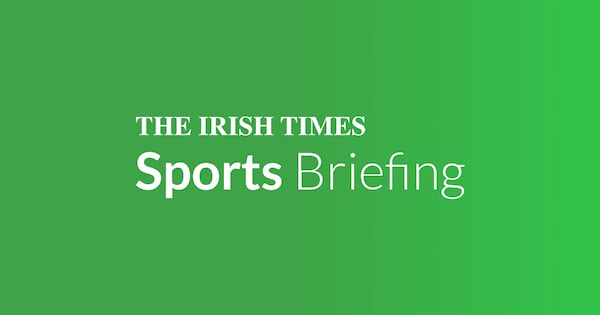Heading into the last weekend of this year’s Wimbledon, with both the men’s and women’s finals taking place, I asked ChatGPT why there were no Irish tennis players in the draw − men, women or juniors.
The answer was comprehensive and covered the same bases that a human being would have done if asked the same question − one that is posed every year when the biggest tennis event arrives in London with no Irish involvement.
There are a number of reasons for this, said the AI.
“Player development and resources: Irish tennis players often don’t have the same level of infrastructure, coaching or financial backing that players from other countries like Spain, France or the US do. Tennis is an expensive sport, and while Ireland does have talent, the resources to support players from a young age in terms of coaching, competition and travel can be limited.
READ MORE
“Ranking and qualification: To compete at Wimbledon, players need to have a high-enough ATP or WTA ranking or successfully qualify through the grass-court season. While there have been talented Irish players in the past (like Conor Niland and James McGee), they may not have consistently maintained a ranking that would earn them direct entry into the tournament or through the qualifying rounds.
“Interest in other sports: Ireland has a rich sporting culture, but tennis doesn’t dominate in the way that Gaelic football, hurling or rugby do. As a result, fewer young athletes might gravitate toward tennis, which means less competition at the elite levels, and fewer players emerging to represent Ireland internationally.”
It read like an answer that could be cut and pasted for many smaller countries, substituting soccer for GAA, yet a look through this year’s Wimbledon draw turns up senior and junior players from Luxembourg, Latvia and Armenia, which have much smaller populations than Ireland.
The 21st and 65th world-ranked women players are Jelena Ostapenko and Anastasija Sevastova, who are from Latvia – population 1.877 million. They both competed in this year’s women’s singles event.

Elina Avanesyan is Armenian (population 2.991 million), and she lost in the first round of the singles 6-2, 6-1 to the world number 11 Elena Rybakina.
Damir Dzumhur from Bosnia-Herzegovina (population 3.185 million), is ranked 69 in the world and automatically qualified for the men’s singles draw on ranking.
There are 128 starters in the men’s and women’s singles draw in each of the four Grand Slam events.
Chris Rodesch is from Luxembourg (population 666,430) and is ranked 172 in the world. He came through the pre-Wimbledon qualifying event to take a place in the men’s main draw.
Maybe the systems and infrastructure in Ireland aren’t there to allow players punch through, but other countries seem to get around the obstacles.
Perhaps the biggest of those is cost. The cost of being on tour and doing all the right things to give a player the best chance of success is not insignificant. It is the factor that most starting out on the professional tour complain is a stumbling block.

Last year the Tennis Gazette spoke to three French professional players to break down some of the day-to-day and week-to-week outlays.
The cost of stringing racquets alone was near €10,000 a year.
“Generally speaking, it’s about 15 racquets per week, at €20 per stringing,” said former top 50 player Constant Lestienne.
“Fifteen times 20 is €300, €300 over 30 weeks adds up to roughly €9,000.”
Terence Atmane came up with about the same figure for stringing racquets but also totted up the cost of hotels, travel, coaching and food.
“I did my accounting, I have my coach who travels with me every week, for the major tournaments. I added physical trainers, plus the training weeks where I covered the costs.
“On top of that, there were two or three tournaments in the Masters 1000 where I went far and the hotel room was expensive, which added up to €7,000-€8,000 in hotel costs.
“I did the math for the year and I spent €200,000 on my staff.”
[ James McGee through to second round of Wimbledon qualifyingOpens in new window ]
Atmane was one of the lucky ones. He earned €392,000 in prize money, so came out on the right side of the ledger.
For the top players it’s a different world. This year’s men’s and women’s singles winners will get €3.48 million from the €62 million Wimbledon prize fund.
In prize money alone the 22-year-old Spaniard Carlos Alcaraz has already accumulated €38.6 million. The retired Roger Federer, now a billionaire, won €111 million during his career. All mouthwatering numbers but the launch pad into that world, even with talent, is not easy, with complaints that the prize money doesn’t filter down.
Still, other sports in Ireland have had success in pushing athletes into elite levels across the spectrum. From a non-traditional sport such as Taekwondo, where Jack Woolley excels, to the likes of cricket, athletics, golf, swimming, gymnastics, rugby and cycling, Ireland has produced world-class athletes. Ben Healy winning a stage in the Tour de France on Thursday is a recent case in point. Irish sport has usually found a way. But not in tennis.
It’s been 14 years since Conor Niland played the first round of Wimbledon, 11 years since James McGee played in the US Open. It’s a pity. But now that ChatGPT has given the definitive answer, maybe Irish tennis can set about doing something before another decade of no participation at Wimbledon slips by again.


















